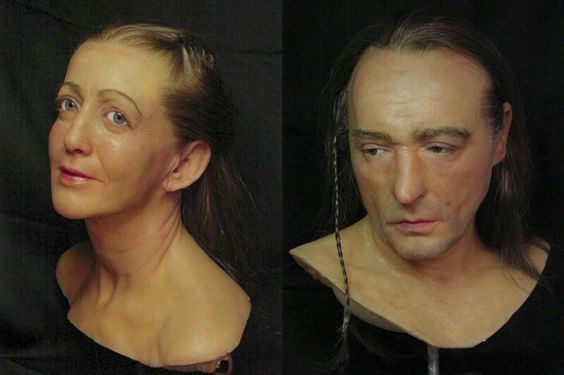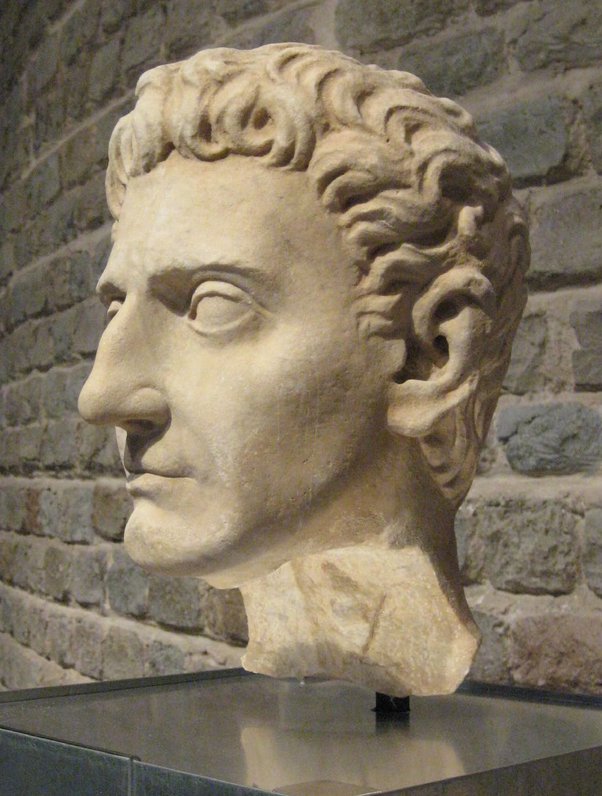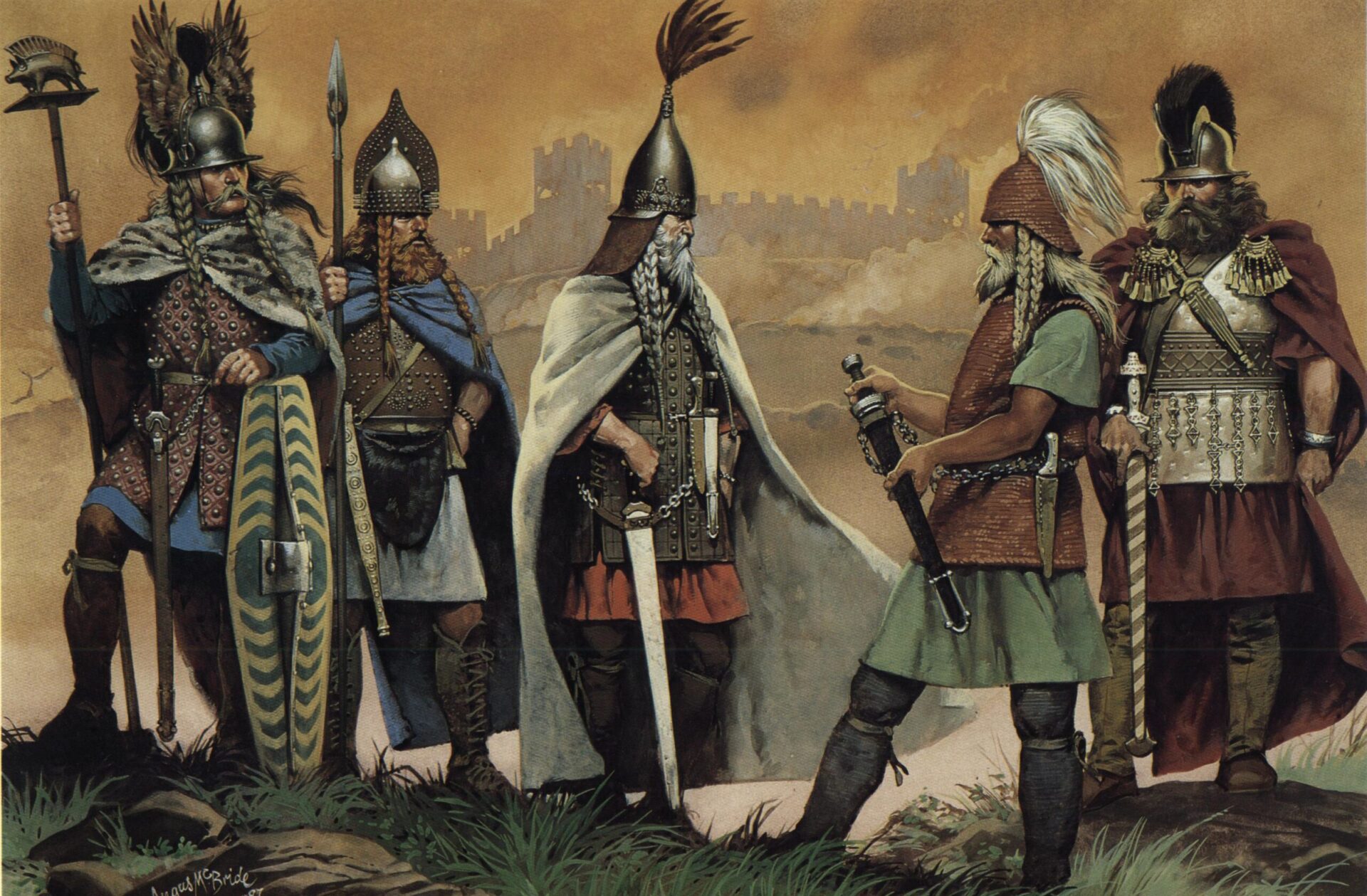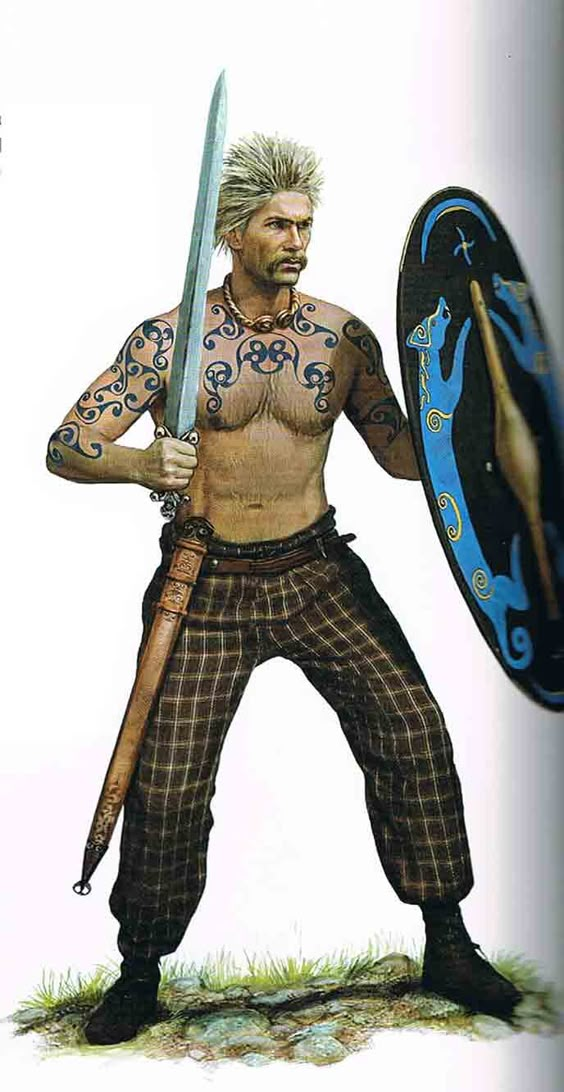The ancient Celtics were the largest group of people in Europe at one time. Most of the Celtics came from Central Europe and migrated westward until they settled in what is now England. Most historians agree that they were aliterate, meaning they had a spoken language but chose not to write things down to ensure the secrecy of their rituals and culture. The oral history survived because of bards and other learned classes.
The earliest written accounts came from the Romans and Greeks, who described them as barbarians. However, recent evidence shows that the Celtics had a complex society and an elevated culture based on their art and metalworking relics.
The Celts didn’t have a central ruler and were a band of a hundred or so tribes. As a result, while they enjoyed their freedom, they fell piecemeal to the Romans and were also overran by Huns, Slavs, and other invading armies.
Facial Features

The Celts are said to have been vain when it came to their appearance. They are said to have had long faces, an aquiline nose, blue or greyish-tinted eyes, and a full head of hair. Most skull evidence also suggests that they had broad foreheads.
Celtic men typically had bushy eyebrows and prominent ears. They also have high cheekbones like the Celtic women. Celtic women typically had a ruddy complexion and a thin, aquiline, regal-looking nose (although there may also have bulbous noses from time to time). They also had thin lips, and their eyes may also have been of other colors, although typecast as green, blue, or greyish. Many people would call them beautiful, but they also have a certain aura of fierceness which could be attributed to their strength.
While there have been efforts to reconstruct ancient Celt faces from skulls, historians can only surmise how they looked based on written accounts.
Facial Hair

According to historians, Celtic men and women took pride in their appearance. Typically, a Celtic man had a full head of hair, which they let grow to acceptable lengths. Most men would also braid their hair, but they didn’t use intricate jewelry or accessories to hold it. Their facial hair is also a symbol of their manliness, as most Celts would have a full beard or, at the very least, a mustache. For the Celts, a man without facial hair would be considered dishonorable. Members of royalty would sport a mustache or a beard that was forked or squared in style. Common Celts would typically fashion their mustaches in a curled manner.
Celtic women typically didn’t have any facial hair but are said to have ruddy faces that reddened after exposure to sunlight and freckles.
Hair Styles

Celtic men had hair of a variety of colors. Some Celtic men had flaming red hair, some blond, some had dark hair, and most of their hair would turn into a regal white due to age. Some dark-haired Celts also whitened their hair with a substance called lime water.
Celtic men wore their hair long, and some would braid them. However, men didn’t use elaborate accessories to keep their hair in place. They also took exceptional pride in their facial hair as they usually sported a full beard and a mustache which they also styled either squared, forked, or curled, depending on their social stature.
Celtic women also had hair of various colors and tended to wear their hair long and in braids. In addition, they typically used bejeweled hair holders to keep their hair in place.
They adorned themselves to express their social status and wealth.
Nose Shape

Ancient Celts are said to have an aquiline or a Roman nose. This means most of the Celts had a prominent, thin nose, which appeared curved or slightly bent, reminiscent of an eagle. Some historians, though, would say that it is a Celtic nose instead of a Roman nose since Romans intermarried into the Celtic tribes because they found Celtic women more beautiful than the genteel Roman women.
While there isn’t a set image for the ancient Celtic nose, historians believe they also may have sported different nose shapes because of genetics and intermingling with other races and tribes.
Height

According to historians who studied ancient skeletons during the Iron Age in Britain, the Celts were typically taller than their Roman counterparts. The tallest male skeleton they examined measured 5 feet 11 inches (1.8 meters), and the smallest one measured 5 feet 2 inches (1.6 meters). Historians surmise that the average male Celtic height was 5 feet 6 inches (1.69 meters).
Historians also found that the average Celtic woman’s height was 5 feet 2 inches (1.6 meters). However, the smallest skeleton they found of a grown Celtic woman was measured at 4 feet 9 inches (1.4 meters), and the tallest was 5 feet 7 inches (1.7 meters).
Some historical accounts state that the Celts were taller than the Romans. However, ancient Roman writers also said that most Celts looked down upon the smaller Romans, which could be taken literally (being actually taller in stature) or figuratively (perhaps because some Romans were considered softer, more sophisticated).
Weight

Based on historical accounts, the ancient Celtics frowned upon obesity and usually levied fines until they got back in shape. As a result, historians surmise that the average Celtic male weighed anywhere between 140 to 160 lbs. Historians also peg Celtic women to weigh anywhere between 100 to 130 lbs.
Since the Celtics hunted wild game and foraged for food, their diet would include the following: wild garlic, apples, spinach, onions, leeks, mushrooms, berries, nettles, carrots, and parsnips. They also had access to walnuts, hazelnuts, blueberries, blackberries and gooseberries, and different types of grains that they turned into porridge and bread.
Celtics would have had a diet consisting of wild boar, deer, foxes, beavers, and bears for their meat. They also domesticated animals such as goats, cattle, swine, and chickens. Celtics who lived near the waterways also fish for mackerel, trout, salmon, and other freshwater or saltwater creatures.
Typical Body

While many historians still couldn’t concretely agree, evidence points to the ancient Celts being mesomorphs based on their diet. They could quickly gain and lose weight without much worry and can eat whatever they want. Historical accounts also say that Celtic society frowned upon obese men and would levy fines until the person had lost weight. They saw this as a sign that the person has taken much without giving back the same amount.
Most Celts were relatively tall for their time, and as Diodorus noted, they had rippling muscles under clear white skin. Anatomically speaking, there isn’t much difference between ancient Celts and modern-day people, although modern-day men’s height, weight, and heft might make them even more daunting than their counterparts.
Makeup Habits

Roman accounts say that the ancient Celts were pretty particular about their appearance and frequently bathed for cleanliness, and they used soap, oils, and scented herbs after a bath.
Celtic women also dyed their fingernails crimson. Celtic men, especially in the higher classes, kept their fingernails well-trimmed. The Celtic women also were said to have dyed their eyebrows black using a natural coloring from a berry. Historians also note that the women (and possibly, men) reddened their cheeks using a plant called ruam, which they believe to be from the alder tree. Celtic priests and missionaries also painted their eyelids black. Finally, celtic women styled their hair into braids or plaits.
Celtic warrior would also dye their hair white using a substance known as lime water. They also painted patterns on their bodies, especially before combat, using woad, which was distinctively blue and was said to have accentuated their skin tone.
Skin Tone

While most historical accounts and stereotypes state that the ancient Celts had a fair complexion, recent studies have revealed that ancient Celts had a darker skin tone than previously believed.
While the Greeks and Romans say that the Celtics had milk-white skin, there may be a part of the Celtic population that sported darker skin and blue eyes, which could have been the result of intermingling with different tribes as the Celts traveled westward during their expansion. Some historians also surmise that the ancient Celts stood out from the Romans and Greeks, who had a darker, olive-skinned complexion than they had with their relatively lighter skin tone and reddish or ginger hair.
It is entirely possible that ancient Celts had different skin tones as they were homogenous and commingled freely with other tribes and races, which they bartered and may have done battle.
Dressing

The ancient Celts dressed based on their social status. Their manner of dress probably looked like the tartans typically sported by the Scots and Irish, replete with checks and stripes. The Celts used wild berries and different plants to dye the wool they used to make their clothes.
Celts loved wearing brightly colored clothes, and they also sported patterns on their bodies which they applied using blue woad. The term Celtic blue is derived from the color.
Celtic men typically wore tunics, a broad belt, a cloak, and breeches. Celtic women wore floor-length skirts or dresses made of wool or linen. The women would also wear cloaks or shawls fastened by broaches, clasps, or pins.
Celts preferred gold, tin, silver, bronze, enamel, or coral jewelry. Most Celtic warriors also wore a torc, which was a circular twisted metal neckband made of bronze, copper, gold, silver, or electrum.